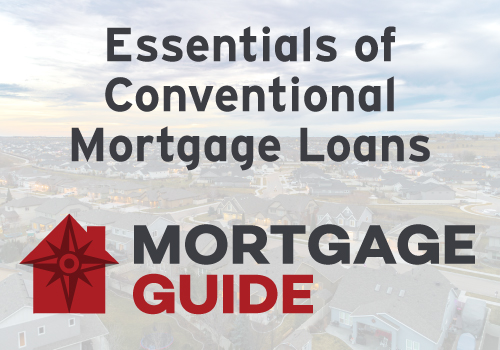Essentials of Conventional Mortgage Loans
02/20/2025

Welcome to another edition of the Mortgage Guide! In this version, we are diving into the essentials of Conventional Mortgage Loans, the most common type of home loan. Let's get started.
What is a Conventional Mortgage Loan?
A conventional mortgage loan is a home loan that is not insured or guaranteed by the federal government, such as the Federal Housing Administration (FHA) or the Department of Veterans Affairs (VA). Conventional loans typically conform to guidelines set by Fannie Mae and Freddie Mac. These guidelines include requirements for credit score, down payment, and debt-to-income ratio.
Who are Fannie and Freddie? The Federal National Mortgage Association, commonly known as "Fannie Mae," and the Federal Home Loan Mortgage Corporation, known as "Freddie Mac," are two government-sponsored enterprises (GSEs) that were chartered by the U.S. Congress in 1938. They neither originate or service mortgage loans. Instead, they buy and guarantee mortgages issued through lenders. The Federal Housing Finance Agency (FHFA) further describes their role as, “Fannie Mae and Freddie Mac buy mortgages from lenders and either hold these mortgages in their portfolios or package the loans into mortgage-backed securities (MBS) that may be sold. Lenders use the cash by selling mortgages to the Enterprises (Fannie and Freddie) to engage in further lending.” The FHFA adds, “They (Fannie and Freddie) perform an important role in the nation’s housing finance system – to provide liquidity, stability, and affordability to the mortgage market.”*
What Does a Conventional Mortgage Loan Look Like?
- Credit Score Requirements
While specific requirements may vary, most conventional loans require a minimum credit score of 620 or higher. A higher credit score often results in a better interest rate and increased loan eligibility. An individual's overall credit history, including payment history, outstanding debt, and credit utilization, are all factors considered in the lending process.
- Down Payment Requirements
The down payment for a mortgage is based on the lower of two values: the purchase price or the home's appraised value. Most conventional loans require a minimum down payment of 5%. However, a few options allow for as little as a 3% down payment. A borrower may need to put down more depending on their credit score and other financial factors. If borrower is capable of a 20% down payment or more, they are not required to have private mortgage insurance (PMI) which lowers their overall loan cost.
- Private Mortgage Insurance (PMI)
If a borrower’s down payment is less than 20%, they will likely be required to pay for Private Mortgage Insurance (PMI). PMI protects the lender if a borrower defaults on their loan. Here's how PMI works:
-
- PMI is typically required for down payments below 20%.
- PMI can be paid monthly, as a lump sum at closing, or a combination of both.
- Once a borrower has paid 20% or more of their loan (achieved that amount of equity), they can request the removal of PMI. Removal of PMI depends on the borrower’s loan type and other conditions.
- Debt-to-Income (DTI) Ratio
The Debt-to-Income (DTI) ratio is critical in determining a borrower’s ability to repay their mortgage. It compares their total monthly debt payments to their gross monthly income.
-
- Front-End DTI: This ratio measures housing expenses (including mortgage payment, taxes, insurance, etc.) relative to a borrower’s income. For conventional loans, this should generally be 32% or less.
-
- Back-End DTI: This ratio includes all debt payments (e.g., credit cards, car loans, student loans) and the mortgage. Conventional loans typically allow a maximum of 45% for the total DTI. However, some flexibility may exist depending on the borrower's credit score and overall financial profile.
A lower DTI ratio is preferred as it signals a borrower is less likely to experience financial strain with a mortgage. However, having a higher DTI ratio doesn't exclude someone from qualifying for a home loan, as additional factors, like a higher credit score or a larger down payment, are also considered.
- Other Important Considerations
-
- Interest Rates – Interest rates can vary based on market conditions and the borrower's financial profile.
-
- Loan Limits - Conventional loans have conforming loan limits set annually by the FHFA. For 2025, the limit for a single-family home, in most areas, is $806,500^. However, this can vary depending on the region of the country.
-
- Mortgage Term: The most common terms are 30 or 15 years, but other options exist.
Recapping Conventional Mortgage Loans
- Credit Score: Minimum 620. Higher credit scores receive better interest rates.
- Down Payment: Can be as low as 3%, but 5% is the most common.
- Private Mortgage Insurance (PMI): Required for down payments less than 20%; can be removed when equity reaches 20%.
- Debt-to-Income (DTI) Ratio: 32% front-end and 45% back-end are typical.
We hope you found this blog helpful and that it has assisted in your journey of financial well-being. If you have a question about mortgages, please reach out to a First Federal Mortgage Loan Professional.
In our next Mortgage Guide we will cover the ins and outs of government loans.
*Source: https://www.fhfa.gov/about/fannie-mae-freddie-mac
^Source: https://www.fhfa.gov/news/news-release/fhfa-announces-conforming-loan-limit-values-for-2025
All credit products subject to approval.
